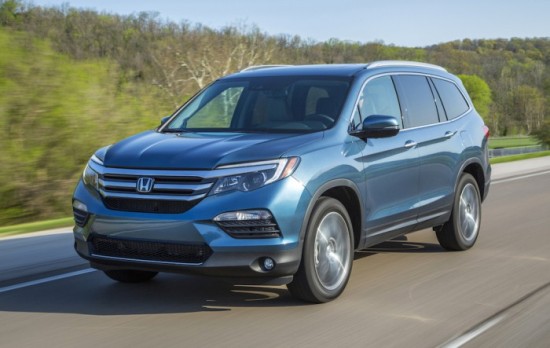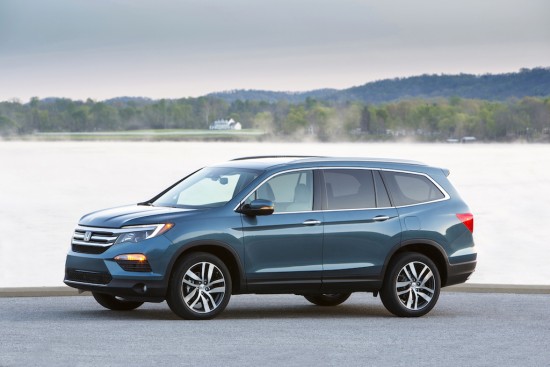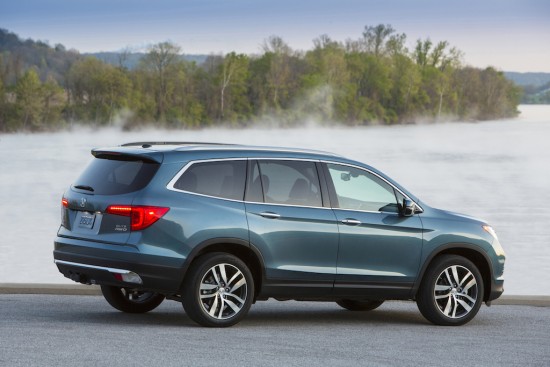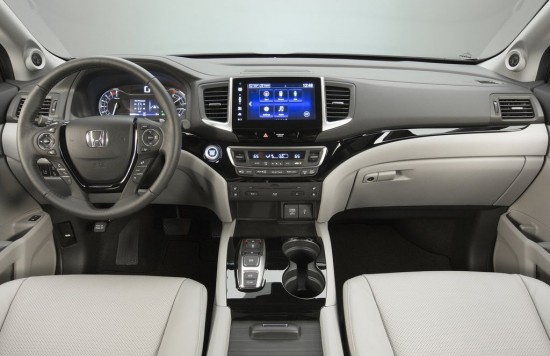*This Review Also Appeared On Fast Lane Daily*
Specs:
Engine: 3.5-liter direct-injection V6 i-VTEC
Horsepower/Torque: 280hp / 262 lb-ft
Transmission: 9-speed automatic
Fuel Economy: 19 city/27 highway/ 22 combined
Layout: 4WD
Price as Tested: $46,420
Review:
On the return drive from Kentucky Motor Speedway, I decided to play a game with the 2016 Honda Pilot’s new safety gadgets. Combining Honda’s adaptive cruise control, lane keeping assist, and road departure mitigation, the simple task was to see how little of driver input was required to direct the Pilot back to Cincinnati.
Here’s how it worked: with little traffic on the highway, mid-day on a Thursday, I could set the adaptive cruise control with an adjustable following distance. Then, I’d let the system find the parameters of the lane. Finally, by just resting a single hand on the bottom or top of the wheel, the combined system inputs would continually adjust as the road curved, and if traffic sped up or slowed. On the highway, without radically sharp turns, I drove for nearly an hour merely overseeing a network of computers “pilot” me (sorry, I had to) to my destination.
In truth, these systems aren’t revolutionary at this stage of the semi-autonomous game, but Honda has managed to fine-tune the combined results of these safety tools to be even better than those in vehicles costing twice as much. In fact, the 2016 Pilot proved to be much like its safety systems: while not revolutionary, certainly best of breed.
The first thing to know about the all-new 2016 Honda Pilot is that it’s five years in the making. With that much time in development, Honda has been able to incorporate the significant changes that have happened in the SUV market while adding trend-setting features of its own.
The first time I laid eyes on the third generation Pilot, my glance didn’t linger. That’s not because it isn’t attractive; on the contrary, the 2016 Pilot has made the transition from boxy to sleek incredibly well. The reason I didn’t dwell on the Pilot was because it shared the stage at the New York International Auto Show with the new Civic concept, in lime green, looking sexy as all hell.
Once I was in Cincinnati, without distractions, the new Pilot received proper attention, and I quickly realized what I had overlooked in New York.
It doesn’t take a trained eye to note the new Pilot’s most distinctive quality – that it looks almost nothing like the current version. And, while the present generation has recognizable, muscular features of a rough-and-tumble SUV, the design is getting a bit long in the tooth. In fact, by the time the 2016 Pilot goes on sale, the present generation Pilot will be seven years old.
The redesign brings smooth creases, exquisite paint colors (Black Forest Pearl is my personal favorite), and host of new accessories that make the Pilot a vehicle you wouldn’t be ashamed to valet at a high-end restaurant, right after you’ve dropped the kids off at soccer practice. Part of the car’s new look is thanks to its longer and lower stance: 3.5 inches were between the front and rear, while the height was lowered by an inch.
A quick aside: at each vehicle launch, I make a point to find the engineers that were let out of their cages to answer the media’s more intricate questions. The truth is that most of the people behind a new vehicle’s development barely get a chance to scratch the surface about why their particular project is significant. That’s why I seek them out, because uncorking their impassioned opinions regarding the vehicle’s complexities gives you the real story.
Related: 2016 Honda Civic Sedan First Drive Review
So, having found just the two gentlemen I was looking for, I began asking the questions they quietly wished someone would ask them. First, I inquired about the aerodynamics. While the change from a blocky to brushed figure certainly was a styling decision, there must have been other reasons. As it turns out, the new shape is responsible for a ten percent improvement in the Pilot’s drag coefficient, contributing the better fuel economy and a quieter ride. As for the chassis, the new light-truck platform has managed to shed 300 pounds thanks to the combination of high strength steel, aluminum, and magnesium. Not only is it lighter, it’s also stiffer and more durable. Fun fact: the current generation Pilot is the lightest in its class, so the new one firmly embarrasses the competition by that metric.
Then we moved on to the second most interesting bit of software on the new Pilot, following the advanced safety systems. The torque vectoring system, called i-VTM4 is seriously advanced for the segment. Unlike most open differential systems available, the i-VTM4 doesn’t use braking to counter traction deficits, but instead uses instant power transfer to the outside wheel. The result is better handling and a more immediate response, without sacrificing performance like a brake-adjusting system. Again, this isn’t revolutionary, but it’s far better than most systems available in this segment. In addition to the torque vectoring component, the four-wheel drive system is paired with a new “Intelligent Traction Management” system that offers four driving modes: normal, snow, mud, and sand. Each mode changes the character of the transmission, differential, and torque-vectoring system to provide the most traction.
The next topic was the transmission. The basic six-speed automatic has been improved for better fuel economy, but the real gem for the redesigned Pilot is the nine-speed automatic. This is a first for Honda and as I would soon discover, the shift-by-wire system is wonderful in both casual and spirited driving. Even the steering wheel-mounted paddle shifters were responsive. This isn’t a vehicle for hot-rodders, but I was thoroughly impressed by how long the transmission would hold a gear when in manual mode; it even locks out the top three gears like automatic transmissions in some sports cars.
As for the engine, that’s all new too. The direct-injection V6 adds 30 horsepower over the current generation Pilot, now rated at 280hp. Torque has been improved as well, now developing 262 pound-feet at 4700 rpm. The extra power moves the Pilot to the top spot among its class in terms of 0-60 acceleration, which ranges between 7.0 and 7.4 seconds. Not only is the engine more powerful, but greater efficiency has led to greater fuel economy; when six-cylinder power isn’t needed, it can run on three cylinders. The six-speed 4WD Pilot averages 26mpg highway and 18mpg city, while the nine-speed 4WD Pilot averages 26 mpg on the highway and 19mpg in the city. The rear-wheel drive versions of each gain one mpg. These figures are matched only by the 2015 Nissan Pathfinder, with its Continuously Variable (and less exciting) transmission.
Having drained the engineers for information, the only thing left to do was test drive the third generation Pilot, and Honda was kind enough to bring along rival vehicles to compare.
Once at the Kentucky Motor Speedway, I decided to begin by familiarizing myself with each of the direct rivals to the Pilot. Here are some of my notes:
Ford Explorer (3.5L V6): Power delivery is immediate, but tapers off too quickly. The vehicle feels extremely wide, but the steering has good weight and direct inputs. Visibility is terrible and the interior is less than intuitive. Handling is competent and the exterior styling is sporty.
Nissan Pathfinder (3.5L V6): The interior has the initial impression of being more luxurious, but becomes bland after a few moments in the cabin. Steering is light, but responsive and the wheel feels excellent to grip. Braking is impressive, and handling is quite good. The CVT is a bore and the styling is uninspired.
Chevrolet Traverse (3.6L V6): The interior has many soft-touch elements and the contrasting colors look good, but the technology is absurdly outdated. Steering is direct, but the handling feels floaty and there’s too much body roll. The brakes are sub-par and exterior styling is un-inspired.
Toyota Highlander (3.5L V6): The interior technology is excellent, but the overall cabin feels too busy. Power in normal drive mode is laughable, but feels vastly improved in sport mode. Braking is good but the pedal feel is spongey. The ride is comfortable. Steering responsiveness is delayed. The new face of the Highlander is one only a [soccer] mother could love.
Now to the Pilot.
Starting with trim levels, there are far more tiers to the Pilot than ever before. The rear-wheel drive 6-speed automatic “LX” starts at just $29,995. Adding 4WD to the mix at any trim level is an additional $1800. The EX trim adds a power driver’s seat, tri-zone climate control, remote start, and body color accents for $32,430. Including Honda’s safety systems is a new trim option above EX and EX-L at an additional cost of $1000, and as I discovered, it’s well-worth the premium. Moving up to the EX-L trim adds leather seats, a power moonroof and tailgate, heated seats, and one-touch power folding rear seats for $36,905. The newly-developed nine-speed automatic is reserved for the Touring and Elite trims, which start at $41,020 in rear-wheel drive setup. Touring bring with it an 8.0-inch Android infotainment system with iPhone connectivity, Siri Eyes-Free and Garmin navigation, “Honda Sensing” safety features (lane keeping assist, adaptive cruise control, road departure mitigation, collision braking mitigation, and forward collision warning), 20-inch alloy wheels, parking sensors, a 10-speaker 540-watt audio system, a total of five USB ports, four of which can charge your device at 2.5 amps, memory seats, chrome door handles, and a 115V outlet.
Finally, we arrive at the new “Elite” trim, which mirrors our as-tested price of $46,420 and comes standard with 4WD and the nine-speed automatic. In this designation, you get all the previous trim options, plus LED headlights and taillights, heated and ventilated front seats, heated second row captains chairs, rain-sensing wipers, a panoramic glass roof, heated steering wheel, blind spot monitoring, rear cross-traffic alert, and HD Radio. It’s an impressive list of standard features that makes the 2016 Pilot feel as much like a luxury car as a utility vehicle.
Even if you don’t opt for the higher spec trims, you receive a generous number of standard features like a reversible cargo lid with two positions, a 5.0-inch color audio system, stop-start technology, 17-inch wheels, cap-less refueling, and an NHTSA 5-star overall crash test/IIHS Top Safety Pick Plus rating. The interior, much like the exterior, looks and feels completely distinct. The hard plastics, chunky gear selector, and spartan tech. features have been replaced by a modern cockpit with soft-touch materials, advanced technology, and wonderfully comfortable seats. While some of the best gadgetry is reserved for the premium trim packages, there’s a lot to love about the new cabin in any specification.
Once you’re done playing with all the new toys, you can take advantage of the redesigned Pilot’s improved driving experience. Again, keeping in mind this is a family-hauler, that 0-60 time of 7.0 seconds is damn impressive, and in traditional V-TEC fashion, the upper part of the rev range is a treat. Stringing out the Pilot’s direct injection six-cylinder is rewarding, and thanks to the progressive power delivery, you aren’t robbed of any lack of low-end torque. Paired with reasonably quick gear changes from the nine-speed automatic’s manual mode, the Pilot manages to pass for “spunky.” The stiffer body and new coilover suspension change direction without drama, and body roll is mitigated quite well. As with most SUVs in this segment, the steering is light, but the Pilot distinguishes itself with responsiveness to driver inputs. Remarkably, the Pilot handles more like a small crossover than a mid-size SUV, something that can’t be said for most of its rivals.
At the conclusion of my time with the 2016 Pilot, I had a mountain of praise to heap on Honda for its significant overhaul, along with a few minor areas for improvement. While the brakes proved to be competent, the pedal feel was somewhat ambiguous, and it felt unnatural how much pressure needed to be applied to cut speed in full-stop situations. Honda’s “Smart Start” system also needs a bit of work. Engine cut off was rather abrupt, and when the light turned green, there was about half a second too long of a delay before the vehicle jumped into gear. Finally, while the Garmin navigation system was intuitive, something about the low-quality graphics felt misplaced in an otherwise modern, premium cabin.
With those few gripes voiced, I’m rather astounded by this redesign. Not only is the new Pilot a giant leap forward for Honda in terms of interior quality, exterior design, and high-tech. equipment, but when each of the competitive vehicles in its class are matched up, there isn’t a single SUV that brings “the whole package” like the 2016 Pilot. When the third generation Pilot rolls off the assembly line in Lincoln, Alabama in June, there will be no mid-size SUV more deserving of your dollar.






